Fitted Gothic Dress
We are turning our attention to the Gothic fitted dress today and its appearance throughout the mid-1300s until the mid-1400s. Our goal is to give an overview of this style while providing images as visual aids. Making your own is quite an ambitious undertaking, but it can be done! Hopefully, you get inspired to challenge yourself and put your sewing skills to the test with this beautiful Gothic style dress.
What is a fitted Gothic Dress?
The Gothic fitted dress can be found in artworks from the mid-1300s until the mid-1400s. This style of dress was prevalent throughout most of Europe and worn by women of all ages and statuses.
The fitted dress was typically worn as an everyday dress and could be used as a supportive under-layer for more formal occasions. The fitted overdress and fitted underdress were two different garments that were worn layered on top of each other. The fitted underdress was usually worn during the daytime without the outerlayer.
Depending on the place and time period, the fitted day-dress was called various names such as “cotte,” “kirtle,” “gonella,” and “cotehardies.”
What does it look like?
This style is defined by its tight-fitting shape that forms and molds to the female form. In fact, the dress is shaped so that it manipulates the figure into an S-shape (which we will discuss in further detail shortly).
The length of the dress reaches down to the ankle, but evidence of longer dresses exists. The ankle-length made it possible for women to continue daily active work and chores. The width of the skirt was originally fairly narrow and grew fuller later in this period.
Sleeves are long and fitted tightly to the arm. Images from the 1300s show closely set buttons on the sleeves, whereas later styles seem to have used hidden lacing or stitching in order to tighten sleeves.
The most notable feature of these dresses are the S-shape silhouette they produce. One characteristic of this posture is the very high and prominent bust. It is now termed in art history as the “Gothic slouch,” this posture is also known for its swayed back and protruding stomach.
The dress formed the female figure such that the stomach would appear pregnant. During this period, the “pregnant” silhouette was a desirable trait that served to highlight a woman’s natural curves. This style works surprisingly well on almost all figures, from thin to fuller body shapes. By raising the bosom and pressing the stomach downwards, a longer waist is created.
The pregnant looking stomach actually accentuates the female shape and curvature to creating a look that was immensely appealing during this period. The most desired look for women during this time was this slouched S-shaped figure. This effect is achieved primarily by the cut of the dress.
The center of visual attraction brought about by this dress is in the lower back. The shape of the dress draws out the dip in the spine and the womanly curves of the hips on almost every body type. The small of the back is where the eye is drawn and is perhaps the most appealing feature of this dress.Incredibly, there is no evidence that any form of understructure was worn beneath the fitted dress. Boning, stays, and layered interlinings had not been introduced into fashion yet. The dress holds no shape until worn. When it is worn, the fabric molds to the body and gives support along the grainlines. It’s form-shaping action comes from its strong flexibility and the pressure it creates in key areas. The dresses’ sculptural abilities derive primarily from its precise cut and shape.
What fabrics were used?
The fitted Gothic dress was made of linen, wool, or silk. Wool was commonly used to make this dress, whereas linen may have be used more for the lining. Linen is favorable for this fitted dress because it molds wonderfully to the figure and is easy to fit. Silk is more difficult to fit because it is less flexible. However, silk has a beautiful look due to its shine and color. All three fabrics offered the durability and strength needed to hold these dresses together and make them last countless days of wear.
How do I make my own dress?
Making your own fitted dress is quite the challenge. Our best idea of what these dresses looked like is through artworks. These images give us an idea of the style prevalent during this period. Patterns were not used at this time to help in the construction of clothing, so none exist for our use today. This makes sewing your own dress a little more difficult.
Most modern experts and enthusiasts of this style strongly recommend staying true to this method of sewing without a pattern. To do so, you must begin by cutting rough shapes from fabric and then fit them directly on the body. After much pinning, cutting, and stitching, you will achieve a perfectly fitted dress.
There are a number of sources online that describe the process of making a fitted dress if you are interested in making your own. Most insist on fitting the dress directly on the body and working with the fabric to get the ideal fit. In this way, a pattern is not necessary because you will alter the shape continuously throughout the fitting process.
The tight fit is able to shape the body because of the side seams. The cut pieces are sewn together with gores added for extra support and a precise fit. A gore is a fabric insert that allows for a better, more flexible fit. The number of gores and their placement depends of the width of the fabric and your individual shape.
The best way to get started is to begin with your lining. Every dress should include a lining to reduce strain on the seams and absorb sweat. Starting with the lining also makes the fitting process incredibly easier because you can fit it first without worrying about any mistakes showing. The lining can then be used as a template when cutting your main outer fabric.
Linen is an ideal choice for lining because it forms to the body well. As mentioned earlier, the outer layer can be linen, wool, or silk. Stay clear of synthetic fibers when sewing your dress. Synthetic fabrics were not used during this period and have some noticeable drawbacks. They do not breathe the way natural fabrics do, nor do they mold to the body the way a fitted dress should. Even cotton resists shaping properly and presents problems for this particular style.
More information about sewing your own fitted Gothic dress may be found online. It is a fun project that lets you create something made specifically for your body type.Where do I look for inspiration?
The best sources we have for fitted Gothic dresses are images. Many artworks provide us with clear sense of the canon of beauty from this period. The S-shape figure is prevalent in many depictions of woman and we can how the fitted dress facilitated this figure.
Here are some great examples of this style of dress to give you a better idea. Hopefully you will be inspired to make your own!
Exampls from Tres Riches Heures du Duc de Berry. c. 1410.





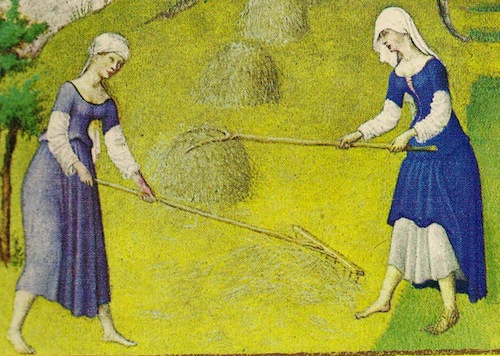
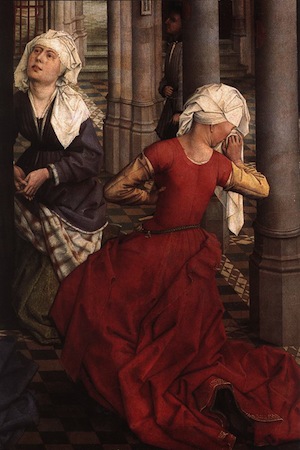
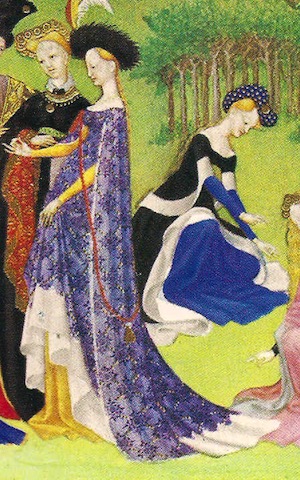
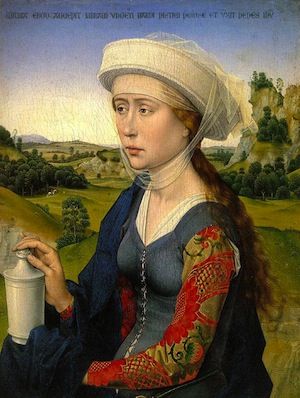
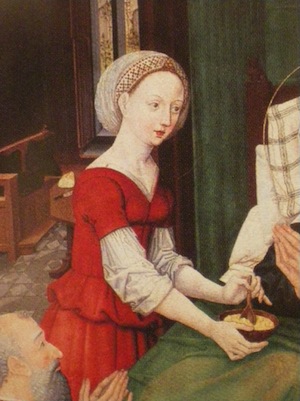
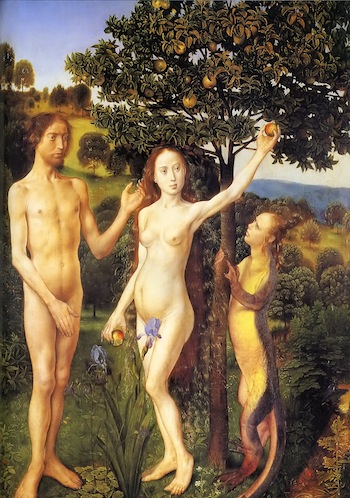
















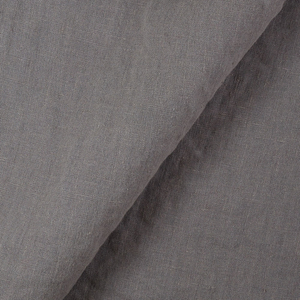


























8 Comments
Robin Netherton
I have just stumbled across this article and am surprised to see that it appears to be notes taken from one of my lectures, point by point, complete with specific details and advice. I am glad that my teaching has been useful, but the person who supplied this article should be reminded to always credit the original researcher/presenter in such a case. It would be appropriate to add a note to this article that this material was taken from a lecture by Robin Netherton in (whatever was the city and year involved;l I gave this specific lecture many times).
Judith
I’m making some GFDs right now, mostly because this is a style that absolutely won’t hide anything about your figure from the waist up. It doesn’t hide anything, but it celebrates and highlights everything. I’ve never felt lovelier than when I’m wearing the Gothic fitted dress. All my historical reenactment garb gets good comments, but when I wear a GFD, I get compliments. I, and not the primarily the dress.
Jackie
Some of the women in the other paintings might be pregnant, but not the Arnolfini one. (this is a common mistake) It is a wedding portrait and the pregnant look is partly due to the cut of the gown and also her posture.
edith W
I would like to comment that the women in the paintings were actually pregnant, not trying to look pregnant. A married woman during that time period would be pregnant more often than not. So, of course, the fashions would emphasize the beauty of pregnancy. The Arnolfini portrait by Jan Van Eyck from 1434 is one that has always struck me as a man being very proud that his wife is pregnant.
Rogues of Thread
Excellent post. You’re making me want to make another kirtle! Here is one I made a while back: http://bythebodkin.wordpress.com/2011/09/06/12c-linen-kirtle-sideless-surcote/
Aside from the whole ‘appearing pregnant’ thing – this style is still the basis for some very attractive dresses!
Suzi
I was very taken by the dress in the picture 3rd from the bottom. I found your article very informative and most interesting. I think you have sparked another interest for me.
nicole novembrino
That image is “The Birth of Mary.” Master of Marienlebens. 1460.
Eryn
Where does the 2nd to last picture, the one of the woman in a red dress holding a bowl and spoon, come from? The construction of the dress is very different, with the V neck and waist seam. I would like to know the date and place of the painting.